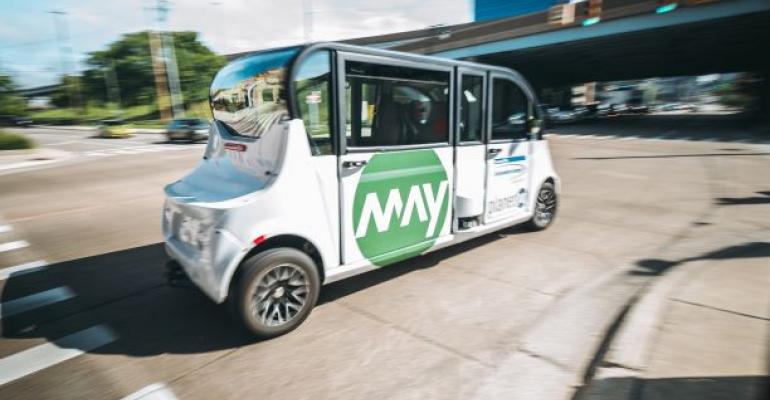The uncomfortable truth about self-driving cars is that there is still not a clear, revenue-generating business model that offsets high R&D costs and turns a profit.
And this was before a global pandemic turned the economy, and our lives, upside down – making human biology just as important as vehicular safety.
However, despite the pandemic and economic crisis, now is arguably the most important time to be paying attention to what is happening with autonomous vehicles (AVs).
 New needs are pushing mobility leaders, policymakers and local and state agencies to work together in novel ways to fight the virus while maintaining staff, revenues and a vision for the future.
New needs are pushing mobility leaders, policymakers and local and state agencies to work together in novel ways to fight the virus while maintaining staff, revenues and a vision for the future.
In the daily grind it can be hard for companies, both new and established, to take a serious look at re-imagining their business model.
Of course, there’s always a close examination of the bottom line, but I’m talking about truly looking at the technology, thinking about the inverse of its use and then working backwards to identify new applications, people and industries it could positively impact.
Here are a few who've done it successfully:
GHSP, a Grand Haven, MI-based automotive supplier, revisited its Ultraviolet Angel technology and found an immediate opportunity to deliver biosafety by developing a new line of treatment products.
GHSP received a PlanetM COVID-19 Mobility Grant from the State of Michigan's new Office of Future Mobility and Electrification to help implement this new product line, which disinfects the air and high-touch surfaces in autonomous shuttles.
They are now working with May Mobility, the AV shuttle service provider, in Grand Rapids, MI, to service the longest autonomous shuttle route in the U.S.
This partnership has provided immediate support in helping combat local concern over passenger health when taking the shuttle service, and offers a template for other shared mobility providers.
Another Michigan-based automotive supplier, Pratt & Miller, was awarded $50,000 by the same Michigan grant program to re-engineer its autonomous passenger vehicle technology to deploy the first large-area autonomous disinfecting robotic vehicle (LaaD) in the U.S.
The LaaD is intended to spray disinfecting material that has an electrostatic component, allowing the material to cling to surfaces more powerfully. It is being rolled out at the Gerald R. Ford International Airport in Grand Rapids.
Adasky is an automotive supplier that has diversified their advanced driver-assistance system during the pandemic. The Israeli-based startup specializes in thermal-imaging camera technology for the AV industry.
Shortly after COVID-19 brought everything to a halt, their team identified a different application for this technology that would take body temperatures in large gathering areas such as airports and shopping centers.
And while Adasky remains very much committed to their automotive roots, this new application is another way they are helping shape public safety while bringing in new revenue opportunities to support the business during an economic downturn.
Nuro, a Silicon-Valley-based AV startup, is proving that business models not only are shifting for AVs but also are scaling.
Forbes has published a story about how COVID-19 has pushed Nuro's self-driving delivery robots to the pole position in Silicon Valley's AV race.
Electric Nuro R2 delivery bots, half the size of a standard passenger car, carry only goods and are designed for urban and suburban streets, with a top speed of 25 mph (38 km/h). Before the pandemic, the company had been focused mainly on a few select retail customers.
However, during the crisis, business has grown 300% as national retail chains including Walmart, Kroger and Domino’s Pizza leveraged the robots to mitigate the virus via contactless robot delivery.
Nuro delivery robots also hauled medical supplies for temporary COVID-19 treatment centers in Sacramento and San Mateo, CA, in April. In May, Nuro launched a pilot in suburban Houston with CVS to deliver prescriptions and other items ordered online.
The list of companies making heroic business model decisions goes on and on.
Even Boston Dynamics is using its autonomous robot dog to help health-care workers talk to coronavirus patients: Spot, a four-legged robot, is being put to use at Brigham and Women’s Hospital in Massachusetts during the pandemic.
With an iPad and two-way radio on the robot, health-care workers videoconference with patients and remotely control Spot as the robot dog walks through rooms with infected or potentially infected patients.
To the general public, self-driving technology always has seemed like a novelty the next generation will enjoy. This sentiment has led most to question whether AV innovations will stall during a time when the word “essential” is preferred over “experimental.”
If anything is taken away from this article, it should be that AV technology development and deployment won’t disappear post-pandemic.
Things will just look and feel different. Competitive advantages will change and more industries will converge to figure out how to make the movement of people and goods safer.
We’re writing the playbook as we go, and while not every pivot is going to be a success, now is certainly the time for the mobility industry, particularly the AV space, to take risks and re-imagine what’s possible.
Trevor Pawl (above) is the Chief Mobility Officer for the State of Michigan and leads Michigan’s Office of Future Mobility and Electrification. He previously served as senior vice president-Business Innovation at the Michigan Economic Development Corp.





